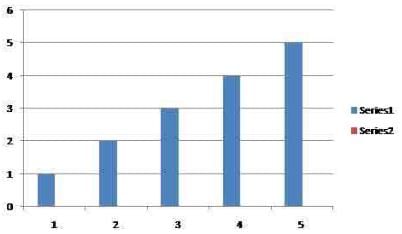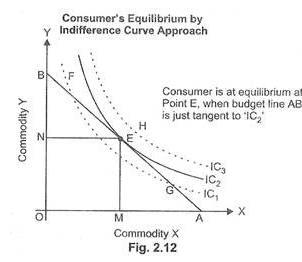B Com Exam > B Com Questions > Explain consumer equilibrium with the help of...
Start Learning for Free
Explain consumer equilibrium with the help of indifference curve?
Verified Answer
Explain consumer equilibrium with the help of indifference curve?
Understanding Consumer’s Equilibrium by Indifference Curve Analysis!
Consumer equilibrium refers to a situation, in which a consumer derives maximum satisfaction, with no intention to change it and subject to given prices and his given income. The point of maximum satisfaction is achieved by studying indifference map and budget line together.

On an indifference map, higher indifference curve represents a higher level of satisfaction than any lower indifference curve. So, a consumer always tries to remain at the highest possible indifference curve, subject to his budget constraint.
Conditions of Consumer’s Equilibrium:
The consumer’s equilibrium under the indifference curve theory must meet the following two conditions:
(i) MRSXY = Ratio of prices or PX/PY
Let the two goods be X and Y. The first condition for consumer’s equilibrium is that
MRSXY = PX/PY
a. If MRSXY > PX/PY, it means that the consumer is willing to pay more for X than the price prevailing in the market. As a result, the consumer buys more of X. As a result, MRS falls till it becomes equal to the ratio of prices and the equilibrium is established.
b. If MRSXY < PX/PY, it means that the consumer is willing to pay less for X than the price prevailing in the market. It induces the consumer to buys less of X and more of Y. As a result, MRS rises till it becomes equal to the ratio of prices and the equilibrium is established.
(ii) MRS continuously falls:
The second condition for consumer’s equilibrium is that MRS must be diminishing at the point of equilibrium, i.e. the indifference curve must be convex to the origin at the point of equilibrium. Unless MRS continuously falls, the equilibrium cannot be established.
Thus, both the conditions need to be fulfilled for a consumer to be in equilibrium.
Let us now understand this with the help of a diagram:

In Fig. 2.12, IC1, IC2 and IC3 are the three indifference curves and AB is the budget line. With the constraint of budget line, the highest indifference curve, which a consumer can reach, is IC2. The budget line is tangent to indifference curve IC2 at point ‘E’. This is the point of consumer equilibrium, where the consumer purchases OM quantity of commodity ‘X’ and ON quantity of commodity ‘Y.
 This question is part of UPSC exam. View all B Com courses
This question is part of UPSC exam. View all B Com courses
Most Upvoted Answer
Explain consumer equilibrium with the help of indifference curve?
Consumer Equilibrium and Indifference Curve:
Consumer equilibrium refers to a situation where a consumer maximizes their satisfaction or utility by allocating their limited income among various goods and services. The concept of consumer equilibrium can be illustrated and analyzed using indifference curves.
1. Indifference Curve:
An indifference curve is a graphical representation that shows different combinations of two goods that provide the same level of utility or satisfaction to a consumer. Each point on the indifference curve represents a different combination of goods, and the consumer is indifferent or equally satisfied with any of those points.
2. Consumer Preferences:
Before understanding consumer equilibrium, it is crucial to comprehend consumer preferences. Consumers have certain preferences or tastes for different goods and services, which can be represented by their indifference curves. The shape and slope of an indifference curve reflect the consumer's preferences.
3. Budget Constraint:
Consumer equilibrium is achieved when the consumer's budget constraint intersects with an indifference curve. The budget constraint represents the limited income or budget of the consumer, and it defines the various combinations of goods that the consumer can afford.
4. Equilibrium Point:
The equilibrium point is the intersection between the budget constraint and the highest attainable indifference curve. At this point, the consumer maximizes their utility, given their budget constraint. The consumer cannot reach a higher indifference curve without exceeding their budget, and any point below the indifference curve would result in lower satisfaction.
5. Optimizing Consumption:
Consumer equilibrium can be determined by analyzing the marginal rate of substitution (MRS) and the ratio of prices of the two goods. The MRS represents the rate at which a consumer is willing to exchange one good for another while maintaining the same level of satisfaction. It is equal to the negative ratio of the marginal utilities of the two goods.
6. Tangency Condition:
At the equilibrium point, the MRS is equal to the price ratio of the two goods. This condition ensures that the consumer optimally allocates their income between the two goods, achieving the maximum level of satisfaction.
7. Changes in Equilibrium:
Consumer equilibrium can change due to various factors such as changes in income, prices of goods, or consumer preferences. These changes would result in a shift of the budget constraint or a different tangent point between the budget constraint and a new indifference curve.
In conclusion, consumer equilibrium is the point where a consumer maximizes their satisfaction or utility by allocating their limited income among different goods and services. Indifference curves help in visualizing and analyzing the consumer's preferences, while the budget constraint and the tangency condition determine the equilibrium point. Understanding consumer equilibrium is essential for analyzing consumer behavior and making informed decisions in the field of economics.
Consumer equilibrium refers to a situation where a consumer maximizes their satisfaction or utility by allocating their limited income among various goods and services. The concept of consumer equilibrium can be illustrated and analyzed using indifference curves.
1. Indifference Curve:
An indifference curve is a graphical representation that shows different combinations of two goods that provide the same level of utility or satisfaction to a consumer. Each point on the indifference curve represents a different combination of goods, and the consumer is indifferent or equally satisfied with any of those points.
2. Consumer Preferences:
Before understanding consumer equilibrium, it is crucial to comprehend consumer preferences. Consumers have certain preferences or tastes for different goods and services, which can be represented by their indifference curves. The shape and slope of an indifference curve reflect the consumer's preferences.
3. Budget Constraint:
Consumer equilibrium is achieved when the consumer's budget constraint intersects with an indifference curve. The budget constraint represents the limited income or budget of the consumer, and it defines the various combinations of goods that the consumer can afford.
4. Equilibrium Point:
The equilibrium point is the intersection between the budget constraint and the highest attainable indifference curve. At this point, the consumer maximizes their utility, given their budget constraint. The consumer cannot reach a higher indifference curve without exceeding their budget, and any point below the indifference curve would result in lower satisfaction.
5. Optimizing Consumption:
Consumer equilibrium can be determined by analyzing the marginal rate of substitution (MRS) and the ratio of prices of the two goods. The MRS represents the rate at which a consumer is willing to exchange one good for another while maintaining the same level of satisfaction. It is equal to the negative ratio of the marginal utilities of the two goods.
6. Tangency Condition:
At the equilibrium point, the MRS is equal to the price ratio of the two goods. This condition ensures that the consumer optimally allocates their income between the two goods, achieving the maximum level of satisfaction.
7. Changes in Equilibrium:
Consumer equilibrium can change due to various factors such as changes in income, prices of goods, or consumer preferences. These changes would result in a shift of the budget constraint or a different tangent point between the budget constraint and a new indifference curve.
In conclusion, consumer equilibrium is the point where a consumer maximizes their satisfaction or utility by allocating their limited income among different goods and services. Indifference curves help in visualizing and analyzing the consumer's preferences, while the budget constraint and the tangency condition determine the equilibrium point. Understanding consumer equilibrium is essential for analyzing consumer behavior and making informed decisions in the field of economics.
Community Answer
Explain consumer equilibrium with the help of indifference curve?
Consumers equilibrium is the amount of goods the consumer can buy in the market given his/her current level of income.
There are two conditions for consumers equilibrium:
1) The first is that the budget line should tangent to the indifference curve or marginal rate of substitution of good X for Good Y (MRSxy) must be equal to the price ratio . i.e MRSxy = Px/Py
2) The indifference curve should be convex to the origin at the point of tangency.
There are two conditions for consumers equilibrium:
1) The first is that the budget line should tangent to the indifference curve or marginal rate of substitution of good X for Good Y (MRSxy) must be equal to the price ratio . i.e MRSxy = Px/Py
2) The indifference curve should be convex to the origin at the point of tangency.

|
Explore Courses for B Com exam
|

|
Similar B Com Doubts
Explain consumer equilibrium with the help of indifference curve?
Question Description
Explain consumer equilibrium with the help of indifference curve? for B Com 2024 is part of B Com preparation. The Question and answers have been prepared according to the B Com exam syllabus. Information about Explain consumer equilibrium with the help of indifference curve? covers all topics & solutions for B Com 2024 Exam. Find important definitions, questions, meanings, examples, exercises and tests below for Explain consumer equilibrium with the help of indifference curve?.
Explain consumer equilibrium with the help of indifference curve? for B Com 2024 is part of B Com preparation. The Question and answers have been prepared according to the B Com exam syllabus. Information about Explain consumer equilibrium with the help of indifference curve? covers all topics & solutions for B Com 2024 Exam. Find important definitions, questions, meanings, examples, exercises and tests below for Explain consumer equilibrium with the help of indifference curve?.
Solutions for Explain consumer equilibrium with the help of indifference curve? in English & in Hindi are available as part of our courses for B Com.
Download more important topics, notes, lectures and mock test series for B Com Exam by signing up for free.
Here you can find the meaning of Explain consumer equilibrium with the help of indifference curve? defined & explained in the simplest way possible. Besides giving the explanation of
Explain consumer equilibrium with the help of indifference curve?, a detailed solution for Explain consumer equilibrium with the help of indifference curve? has been provided alongside types of Explain consumer equilibrium with the help of indifference curve? theory, EduRev gives you an
ample number of questions to practice Explain consumer equilibrium with the help of indifference curve? tests, examples and also practice B Com tests.

|
Explore Courses for B Com exam
|

|
Suggested Free Tests
Signup for Free!
Signup to see your scores go up within 7 days! Learn & Practice with 1000+ FREE Notes, Videos & Tests.



















